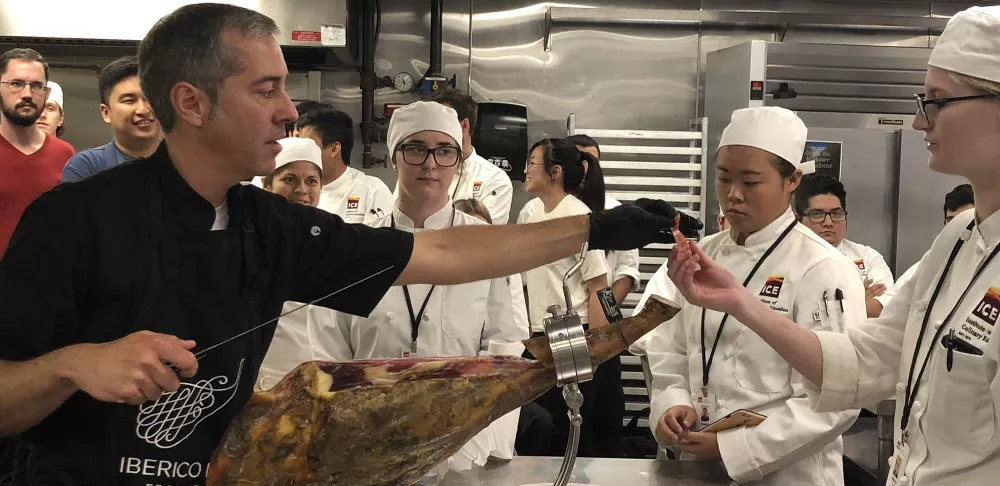Spain’s jamón Ibérico is one of the most coveted hams in the world. Produced from Iberian black pigs (pata negra) that have a specific diet consisting of bellota (acorns), the ham retails for roughly $1,000 per leg. Last week at ICE’s Los Angeles campus, students had a chance to sample the delicacy and learn about its history and production process with master carver Manuel Recio as part of a day of seminars dedicated to Spanish cuisine.
If you’ve ever visited Spain, you probably noticed that ham is everywhere. You may have awed at ham legs hanging from shop ceilings like pork chandeliers and downed several glasses of albariño while munching on silky slices of jamón. But what you might not have realized is that not all Spanish ham is created equal.
“Jamón Ibérico is the gastronomic jewel of Spain,” said Manuel Recio, master carver, or cortador de jamón. According to Recio, there is not an area in Spain that does not proudly serve this scarlet red, glistening ham. “However, the majority of ham from Spain is jamón Serrano,” Recio said. Serrano is similar to prosciutto, although unlike the Italian ham, it’s cured in salt with no brine. Only seven percent of the ham produced in Spain is Ibérico because the artisanal product takes time and skill to procure.

Jamón Ibérico is produced in four specific provinces (Guijuelo, Jabugo, Los Pedroches and Extremadura) in the western and southwestern parts of the country, which host high mountain meadows. There, man-made dehesa habitats have existed for centuries with three kinds of oak trees (gall, holm and cork) that drop acorns into pastures. Here, pigs consume herbs, grasses and the acorns.
From April through September, the pigs in the dehesa graze on herbs, legumes, mushrooms and grass. Montanera, a period from October to March, is the fattening season when acorns fall. We learned from Recio that the acorns are composed of 45 percent sugars. “It’s just like dropping chocolate chip cookies all over the dehesa,” he said. “The pigs go crazy trying to eat all of these acorns.”
Ibérico pigs typically have long snouts and long, slender legs, and almost all are black. “Genetically, they have a unique ability to transform nutrients from the bellotas [acorns] into intramuscular fibers,” Recio said.
Once the pig is “sacrificed” as Recio respectfully puts it, the meat is naturally dry cured — not brined nor smoked — then covered in sea salt and hung to age.
Similar to the beef dry-aging process that we learned about from Adam Perry Lang, the environmental conditions play a critical role in Spain’s jamón aging process, which is centuries-old. Water is sprinkled on the floor of aging bodegas (storerooms) to create humidity, and windows are opened for air flow. “They are in very specific places in Spain where the environment is perfect for curing: A bit cooler, ranging anywhere from 55 to 65 degrees,” Recio said.
The first step for curing is salting. The legs are stacked in the saldadero (salting room), packed with sea salt and frequently rotated. The next step, called profiling, determines how much fat to leave on the meat. “Too much fat and it’ll cure unevenly and take too long. Too little fat, then it’ll dry out very quickly,” Recio says.
Next, it goes to the secadero (drying room) to hang for a minimum of two years, though many producers age for three to four years. Then someone with a trained nose, el calador, “pokes the jamón [with a cala] in different parts to tell if it’s ready or not to be released,” Recio explained. “Much like a master sommelier smells wine.”
The final and most critical step is presentation, which falls on the chef. “All this work went into creating this beautiful jamón,” Recio said. “It’s up to you to transmit that and add your own personal message to it for your customers.”

For Americans and amateurs, here’s what to keep in mind when serving jamón Ibérico:
- Appearance: Jamón Ibérico should be deep red, bright and glossy due to all the omega acid. The fat should be fluid, almost dripping — that’s how you can tell if it’s 100 percent Ibérico. There should be protein crystals in the jamón, similar to aged Parmigiano cheese.
- Cutting: Always start cutting with the maza (bottom) on top, as it has the most fat and will produce the showcase slices.
- Serving: Slices should always be transparent, not thick, for optimal flavor. Each slice should be about 1.5 ounces, or the size of a business card. Always serve jamón Ibérico at room temperature.
Take advantage of demonstrations, lectures and global flavors in ICE’s Culinary Arts program in Los Angeles.




